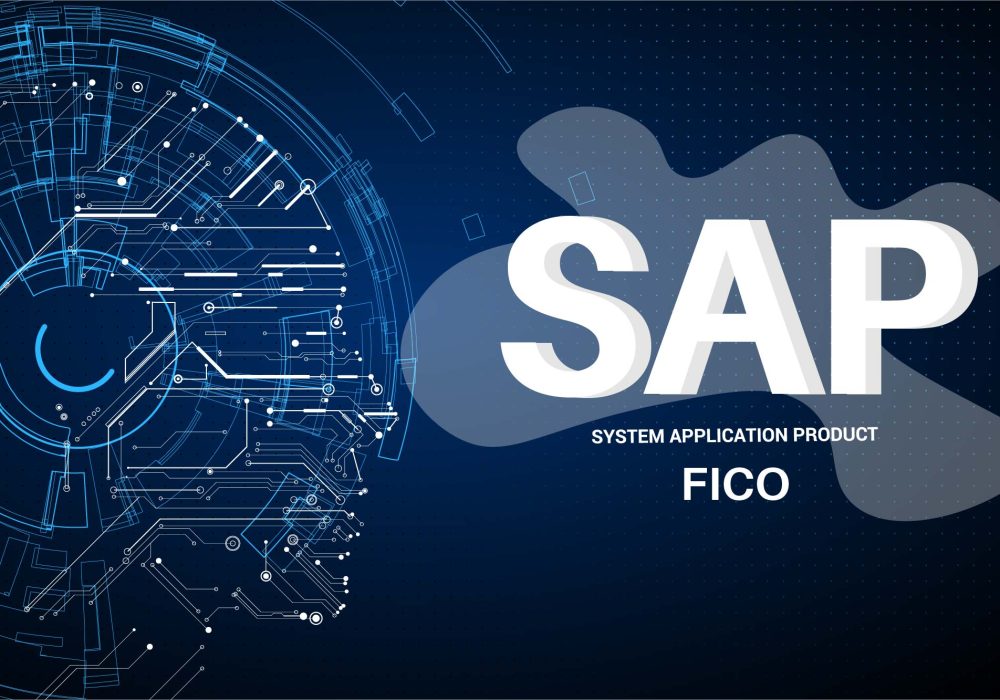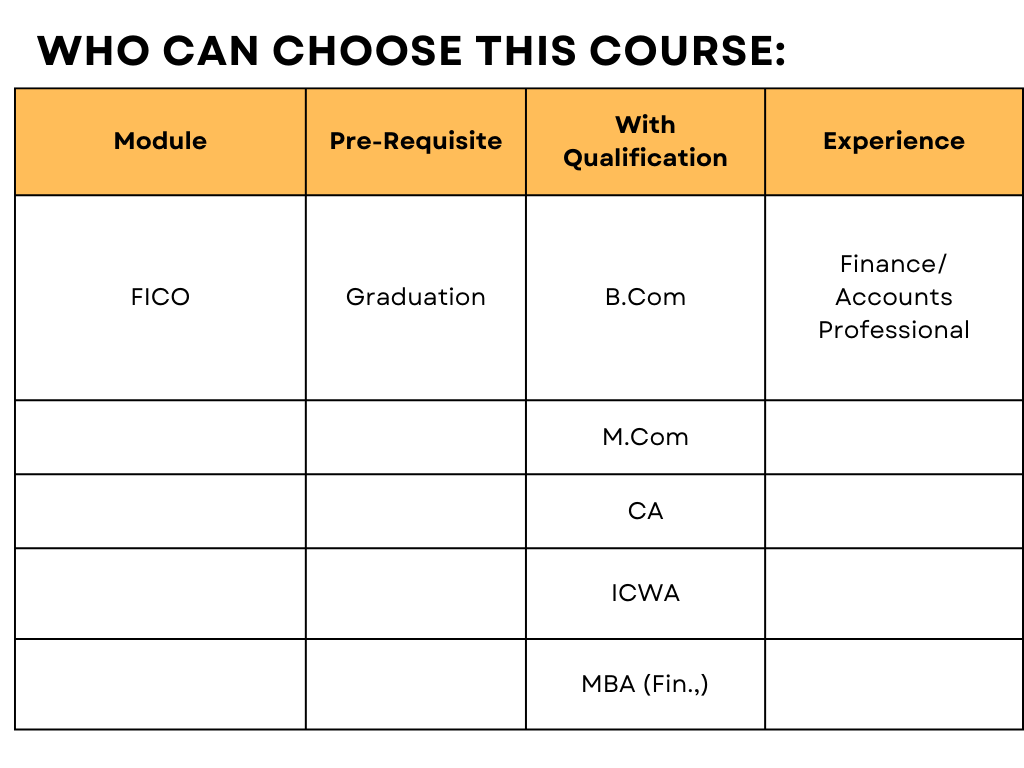SAP-FICO
SAP Finance & Controlling (FICO) Module is a Functional Module of SAP Software. Finance activity or processes of an Organization is mapped with the help of FICO Module. Professionals who are working in Finance Dept., in various function can opt for FICO Module. Apart from Accounts or Finance Professionals, people who are graduated with B Com , M. Com, CA, ICWA, MBA (Finance) etc., Degrees can also learn FICO Module and become a Consultant in SAP.

Eligibility for a course typically depends on the following:
- Prerequisites: Required prior courses or skills.
- Level of Study: Undergraduate, graduate, or continuing education.
- Program Requirements: Specific to your major or program.
- Open Enrollment: Available to all students as an elective.
- Special Permissions: Might need instructor or department approval.
- Availability: Limited seats may give priority to certain students.
- Location/Delivery: Online or specific campus availability.
Check the course catalog or consult with an academic advisor for specifics.

SAP-FI/CO COURSE CONTENT
I. Introduction:
1. Introduction to ERP, Advantages of SAP over other ERP Packages
2. Introduction to SAP R/3 – S/4 HANA Finance
3. System Landscape
4. System Architectures
5. Introduction to G/L (NEW G/L), A/R, A/P, AA.
6. Introduction to Banking and Treasury Management.
7. Introduction to CEA, CCA, EC- PCA, CO-PA and PC.
II. Financial Accounting Basic Settings:
1. Creation and assignment of company and company code
2. Creation of business area, Consolidation Business area, Functional Area, Financial Management Area, Segment and Credit Control Area and Assignment.
3. Creating Leading, Non- Leading and Rep- Ledger.(New GL Accounting)
4. Defining and assignment of fiscal year variant, Posting Period Variant, Open and Close Posting Periods.
5. Defining Document type &Number ranges
6. Define Posting Keys.
7. Maintenance and assignment of field status variants
8. Defining and assignment of Tolerance groups of employees, General Ledger.
9. Assign User Tolerance Groups.
10. Taxes on Sales & Purchases (Basic Settings)
11. Creation of Chart of Accounts, Account Groups and Retained Earnings.
III. General Ledger Accounting:
1. Creation of General Ledger Master (with and without reference)
2. LSMW- Legacy System Migration Workbench.
3. Display/Change/Block/Unblock of general ledger master
4. Creation of Account Assignment model and posting
5. Defining Recurring entry document, Run Schedule, Run Dates and posting
6. Creation of Sample Document and posting
7. Interest Configuration (Balance Interest).
8. Configuration of line layouts for display of GL line items.
9. Create Screen Layouts.
Testing:
1. Document Entry posting normal postings posting with reference
2. Display and change of documents.
3. Display of GL balances and Line items
4. Parked documents & hold documents
5. Reversal of individual documents, mass Reversal, reversal of cleared items and reversal of accrual and deferral documents.
IV. Bank Configuration:
1. House Bank Application, Creation, Mapping of GL Accounts.
2. Cheque Lot Creation.
3. Cash Journal/ Petty Cash.
4. Bank account interest calculation
5. Lockbox Principles
6. Bank Reconciliation Statements.
A. Automatic Bank Reconciliation.
B. Manual Bank Reconciliation.
V. Accounts Receivable (Customer):
1. Creation of Customer account groups and assignment of number ranges
2. LSMW – Legacy System Migration Workbench.
3. Creation of Tolerance group for customers
4. Creation of Customer Master (Display/Change/Block/un-block of Customer Master)
5. Interest Configuration. (A/R)
6. Down Payment Creation and Configuration
7. Bills of Exchange.
8. Customer Terms. (Fix Day & Number of Days Method)
9. Customer Discounts and Methods.
10. Reserve for Bad-debts. (Basic Settings and Master Data)
11. Configuration of settings for Dunning.
12. Automatic Clearing.
VI. Accounts Payable (Vendor):
1. Creation of Vendor Account groups and assignment of number ranges
2. LSMW – Legacy System Migration Workbench.
3. Creation of Vendor Master (display/change/block/un-block of vender master)
4. Creation of Tolerance group for venders
5. Interest Configuration.
6. Down Payment Creation and Configuration.
7. Terms of Payment. (Vendor Installments)
8. Creation of House banks and Technical Ids.
9. Configuration of Automatic payment program
10. Defining correspondence & party statement of accounts.
11. Automatic Clearing.
X. Taxes:
1. Withholding Tax. (TDS)
2. Global Taxes.
3. GST (In-depth)
Testing.
1. Posting of customer transactions (sales invoice posting, payment posting, debit memo).
2. Settings for advance payment from parties (down payment).
3. Defining correspondence & party statement of accounts.
4. Posting of vendor transactions (invoice posting, payment posting, credit memo).
5. Settings for advance payments to parties (down payment) and clearing of down payment against invoices (special GL transactions).
6. Posting of partial Payment & Residual Payment.
7. Payment to vendors through APP.
8. Asset under Construction.
Xii. Data Migration:
LSMW – Legacy System Migration Workbench. (Batch input Method, I-Doc)
Asset Accounting:
1. Defining chart of depreciation
2. Defining Account Determination, screen layout, number ranges and asset classes.
3. Integration with General Ledger (AO90) & Posting rules. (OAYR)
4. Creation of asset master and sub asset master (change/display/block/unblock).
5. Defining Depreciation key (base, declining, multilevel, period control methods).
6. Acquisition or purchase of assets, sale of assets.
7. Scrapping of assets, Transfer of assets.
8. Post Capitalization and write up.
9. Depreciation run.
10. Line Settle of assets under construction of capital work in progress.
Testing.
1. Asset Purchase Posting.
2. Sale of Asset.
3. Transfer of Asset.
4. Scrapping of Asset.
5. Depreciation Run
VII. Cross- Company Code Transactions:
New GL Accounting:
1. Define Field Status Variant
2. Define Currencies of Leading Ledger
3. Assign Scenario and Customer Fields to Ledger
4. Assign Posting Period Variant to Company Code
5. Define Accounting principles
6. Assign Accounting principles to Ledger Groups
7. Assign Variant for Real Time Integration to Company Code
8. Define Document Number Ranges for Entry View
9. Define Document Number Ranges for General Ledger View
10. Define Document Type for Entry View in a Ledger
11. Define Document Type for General Ledger View
12. Change Message Control
13. Classify Document Type for Document Splitting
14. Activate Document Splitting
15. Define Zero Balance Clearing Account
16. Document Splitting Characteristics
17. Define Posting Keys for Incoming Invoices a7 Credit Memo
18. Set Country Specific Check
19. Create Dummy Profit Centre.
VIII. Integration with MM.
1. Movement types.
2. Valuation class.
3. Valuation area.
4. Process key.
5. Valuation grouping.
6. Material types.
7. Define plant.
8. Define division.
9. Maintain storage location.
10. Maintain purchasing organization.
11. Assign plant to company code.
12. Assign business area to plant/valuation area and division.
13. Assign purchasing organization to company code.
14. Creation of material group.
15. Maintain company code for material management.
16. Define attributes of material types.
17. Set tolerance group for purchase orders.
18. Set tolerance limits group for goods receipt.
19. Plant parameters.
20. Maintain default values for tax codes.
21. Set tolerance limits for goods receipt.
22. Plant parameters.
23. Maintain default values for tax codes.
24. Set tolerance limits for invoice verification.
25. Define automatic status change.
26. Group together valuation areas.
27. Configure automatic posting.
28. Document type & number ranges.
29. Material master creation.
30. To open material periods.
Testing:
a. Purchase Requisition (ME51N)
b. Purchase Order (ME21N)
c. Goods Receipt (MIGO)
d. Invoice Verification (MIRO)
e. Payment to Vendor: F-53/ F110
xiii. Integration with SD.
1. Define sales organization.
2. Define distribution channel.
3. Define shipping point.
4. Assign sales organization to company code.
5. Assign distribution channel to sales organization.
6. Assign division to sales organization.
7. Setup sales area.
8. Assign sales organization distribution channel plant.
9. Define rules by sales area.
10. Assign shipping point to plant.
11. Define pricing procedure determination.
12. Define tax determination rules.
13. Assignment of accounts for automatic postings.
14. Setup partner determination.
15. Assign shipping points.
16. Creation of condition types.
Testing:
a. Sales Quotation (VA21)
b. Sales Order (VA01)
c. Delivery against Sales Order (VL01N)
d. Customer Billing (VF01)
e. Customer Payment (F-28)
IX. Screen Variants.
X. User Creation. (Basis Consultant Roles)
1. User Creation
2. Role Authorizations.
3. Assign Tolerance to Users.
4. Transport Request Creation and Maintenance.
XI. FI/ SD Credit Management.
1. Define credit controlling areas.
2. Define Risk Categories
3. Define Credit Groups
4. Assign Sales Document & Delivery Document.
XII. Cutover Activities.
1. Receivable Takeover.
2. Payable Takeover.
3. Asset Takeover.
4. GL Takeover.
XIII. Final Preparation.
1. Define Financial Statement Version.
2. Balance carry forward Balances.
3. Month ending Activities.
4. Structure of Account Balances.
5. FI- CO Tables.
XIV. Reports.
1. Financial statement version.
2. General Ledger, Accounts Payable, Accounts Receivable and Assets Reports.
3. Functional Specifications
4. RICEF REPORTS
CONTROLLING
XV. Basic settings for controlling
1. Maintain Controlling Area.
2. Activate control indicators/ components.
3. Defining Number ranges for Controlling Area.
4. Maintain Planning Versions.
XVI. Cost Element Accounting.
1. Creation of Primary and Secondary Cost Elements.
2. Creation of Cost Element Groups.
3. Primary cost element categories and secondary cost element categories.
XVII. Cost Center Accounting
1. Defining Cost Center Standard Hierarchy.
2. Creation of Cost Centers and cost center groups.
3. Planning for cost center, posting to cost centers.
4. Repost of Costs.
5. Overhead Calculation.
6. Creation and Execution of Distribution Cycle.
7. Creation and execution of assessment cycles.
8. cost center reports
XVIII. Internal Orders
1. Statistical Internal Order.
2. Real Internal Order.
3. Defining order types.
4. Creation of internal orders.
5. Planning of internal orders.
6. Postings to internal order.
7. Report of Variance analysis.
XIX. Profit Center Accounting.
1. Basic Settings for Profit Center Accounting.
2. Creation of Dummy Profit Centers.
3. Maintaining versions for profit centers.
4. Creation of profit centers and profit center groups.
5. Creation of revenue cost elements.
6. Automatic Assignment of Revenue elements for Profit Centers.
7. Postings to profit centers, planning and variance reporting.
XX. Commitment Management.
1. Assign Fiscal Year Variant to F.M Area
2. Assign Field Status Variant to Company Code
3. Create Field Status Variant
4. Create Commitment Item
5. Mapping of Commitment Item
6. Enter Values into Commitment Item
XXI. Budgetary Control
XXII. Product Costing.
1. Define Cost Sheet.
2. Define cost component structure.
3. Define MRP controller.
4. Define production controller.
5. Create bill of material.
XXIII. Profitability Analysis.
1. Defining the operating concern.
2. Define profitability segment characteristics.
3. Activating the profitability analysis.
4. Creation of data structures.
5. Follow of actual values.
6. Creation of reports.
7. Execution of reports.
8. Define forms.
